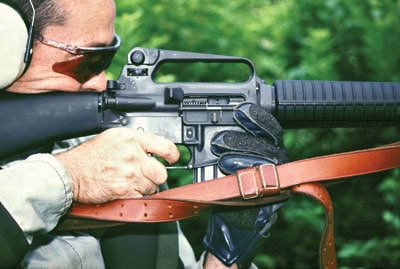| Uncategorized |
2
This whole system, the buffer system, is dang near unique to the AR-15. It’s very different than other rifle designs, especially those it superseded, and especially considering when it was conceived and introduced. The idea of containing recoil forces inside the rifle made for a new-think weapon easy to control and gain confidence and proficiency with. We can argue around all the particular points of goods, bads and indifferents accompanying the “switch” away from the “Garand-style” systems, but in this one, “friendliness,” was no doubt a huge asset to troop training.However! The buffer system is another system within a system, another set of moving parts. As such, and as a system, its elements and the functionality create their own sets of standards and options. Lemme clarify: there are different sets of buffer system pieces/parts for different AR-15-based configurations.

Getting your AR up and running as smoothly as possible is key to wringing out the most performance. Rifle-length ARs like this tend to run well, but carbines can introduce issues.
Primarily, short guns need and get the most attention. A standard-format rifle-length AR-15 isn’t overly (if at all) problematic with respect to cycling. However, the carbine-size AR’s can be problematic. The problem is overactive cycling. Too much gas enters the system too soon. Specific symptoms or reactions result, and extraction and feeding problems — or both — are the ultimate consequence.
I know the way I write about it in these pages, it must sound like I think the AR-15 gas system is just corrupt engineering … . The problem isn’t in the design. It’s in the redesign.
Now, don’t think “they” didn’t know what they were doing in setting up the carbine system. It was at least a bit intentionally overgassed to help ensure reliable functioning, but there’s a little less room for margin in the shorter gun. Given a specific load to build system dimensions around (issue ball ammo) a little overgassed isn’t disastrous. But when there are other minor or more major changes or options applied to a carbine-type AR, and the system is not redimensioned, it can become a lot overgassed.
The carbine version of the AR needed a shorter upper receiver extension tube, and therefore a shorter buffer, and, of course, shorter spring. A shorter buffer also means it’s lighter.
When the bolt is in battery, the buffer is holding pressure, via the buffer spring, against the back of the bolt carrier. The buffer is therefore an effectively integral part of the bolt carrier. If it’s holding against the carrier under greater pressure, or if the buffer is heavier, either and both of those create an effectively heavier, and slower-reacting bolt carrier. That, almost always, is a good thing.

Rifle and carbine standard buffers and buffer springs. The carbine needs a shorter buffer and it’s also a lighter buffer—about 2 ounces lighter. That’s a whopping influence in a world running in milliseconds.

If you’re going to tune a spring by cutting coils, count them. Don’t measure the spring length. Rifle “standard” is usually 43 coils, and it’s 37 for carbines. So, if you want a carbine spring from a rifle spring, count down six coils and zip it right there.
Altered gas port locations and sizes (can only be done on a custom rebarreling), adjustable-flow gas manifolds, or both, make big differences. So too, as mentioned, do heavier-weight carriers. Those resist initial movement for a speck longer, giving internal pressures longer to subside. The easier means are related to the “back part” of the system, which let’s say is the buffering apparatus. It can be altered to influence bolt carrier movement. A carrier slower to move under influence of gas pressure gives a tick or three more time for internal pressures to subside.
As mentioned, one of the foibles of carbine architecture is the shorter buffer, which is also a lighter buffer. Increasing buffer weight is effective and easy. More weight, harder to push and pushes slower.
Another way to effectively increase buffer weight can be done with a different buffer spring. I’ve decided for myself there’s really no such thing as a “standard” spring for rifles or carbines. There are differences in how different examples compress and rebound, and if you measure enough of them you’ll record different lengths. More checks will show, though, that most have the same number of coils. Any more I just trim rifle-length buffer springs to make them work.
David Tubb, umpteen-time NRA High Power Rifle and Long-Range Rifle champion, markets a “flat-wire” buffer spring that works very well. It’s made from 17-7PH stainless steel, a radically better material than music wire. Since the coils are flat, the compressed length or “solid height” of the spring (fully compressed) is much shorter than a round-wire spring can attain. This means, if needed, an effectively stronger spring can fit into a carbine buffer tube without overly compressing into a solid structure and impeding function.
The longer flat-wire spring adds a little extra pressure to aid in keeping the carrier still a tick longer, even though I don’t really see it as an “extra-power” spring. One will increase “in-battery load” about 25 percent. That’s significant.
There are a whopping lot of accessory buffers available on the market. As guessed, the influential option is weight. They range from a little lighter, for those running custom-spec low-mass carrier arrangements, to, for the major-most part, those a little to a lot heavier. Standard carbine buffer weight is 3 ounces. If you take apart a standard carbine buffer (punch out the retaining pin), inside you’ll find three steel weights and three rubber pads. Heavier buffers are not a new idea. Colt developed different-weight buffers for different applications: the H1 (3.8 ozs.), H2 (4.6 ozs.) and H3 (5.4 ozs.). The H1 uses two steel weights and one tungsten weight, the H2 uses two tungsten and one steel weight, and the H3 uses three tungsten weights.

Here’s Glen’s choice, and he runs these in all his AR’s, short, medium, and long rifle configurations. It’s an “AR-restor” from ITT (Enidine). Rather than only increasing mass, it incorporates a hydraulic component and works like a shock absorber. Shown are three carbine-length variants.

Primary Weapons Systems buffers also work well and are well made. This is a 4.5-ounce replicant of the Colt H2.

Other buffer options, like those from Spike’s Tactical, are available in various weights, depending, of course, on how much lag is needed. One or two ounces is a world of difference. This is an ST-T3 Tungsten Heavy, 5.4-ounce.
The only thing I’ve encountered (but only a couple of times) with replacement buffers is making sure there is enough “room” for the bolt stop to function when it all bottoms out. If not, the fix is removing a little material from the back end of the buffer (after determining that it’s not an overly-long spring hitting solid height creating the problem), which is easily done since it’s plastic.
Any and all of these changes have to be qualified as appropriate for use under one set of conditions. Not all perform in the same way on different rifles with different ammunition. Make double-dang sure any change in ammunition, especially, is thoroughly tested for function with your setup. Very (seemingly) small changes in cartridge pressures, for instance, can have big effects.

With any buffer change, make sure there is enough overrun (gap) between bolt and bolt stop to ensure bolt-stop function. A nickel’s width is the minimum. Less than this might not give the latch time to spring up into position.
The capacity of an “impulse” gas system is regulated only by gas tube and barrel gas port hole dimensions. Gas port pressure is the amount of gas pressure at the gas port. Port pressure determines, mostly, the “timing” of system operation. If too much gas flows in too soon, the system has no choice but to function. The bolt will unlock too soon as the system begins moving the bolt carrier to the rear.
Then, the cartridge case gets yanked while it’s still expanded inside the chamber. This creates the “extraction” problems common to carbines. It’s really not an extraction problem, but a timing issue. Additionally, the overdose of gas creates overly high bolt carrier velocity going back. It can get so high the carrier will “bounce” off its rearward stopping point and rebound overly quickly going back ahead. The resultant malfunction, a failure to feed, appears like a “short-stroke” or abbreviated cycle but its cause is really just the opposite.
Overrides (failure to pick up a round from the magazine) and failure of the bolt to lock back against the bolt catch (or bolt stop) can result because the carrier is outrunning the magazine follower’s ability to push up the next round, or engage the bolt stop quickly enough. For more info: www.americanhandgunner.com/index
Information in this article was adapted from The Competitive AR-15: The Ultimate Technical Guide, published by Zediker Publishing. For more, including downloads, check ZedikerPublishing.com, or purchase Glen’s books at BuyZedikerBooks.com.


